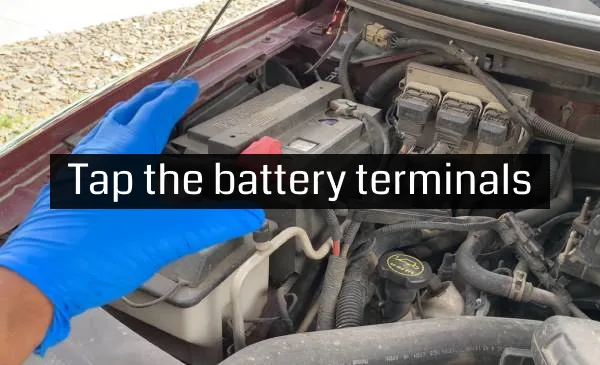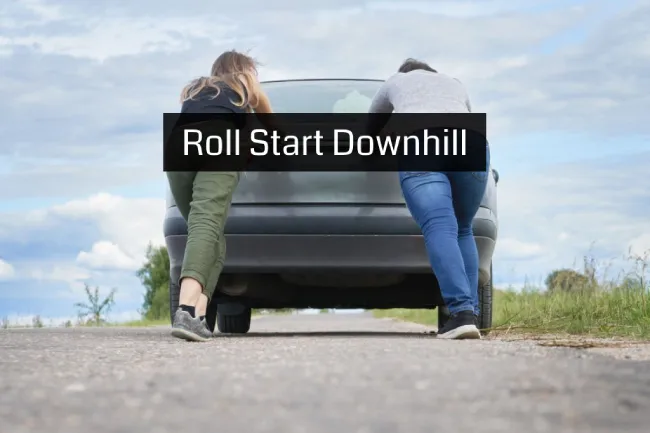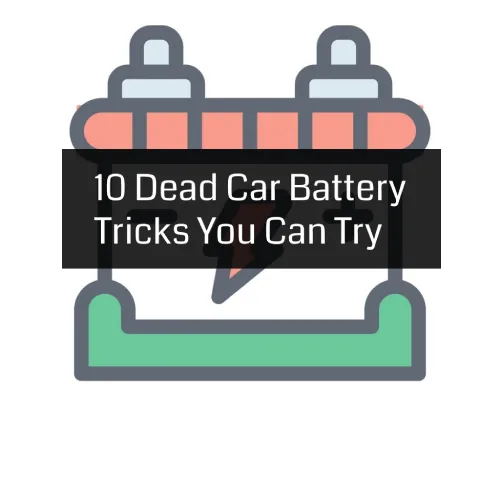As a mechanic with over 20 years turning wrenches, I’ve seen my fair share of dead car batteries. Believe me, there’s nothing more frustrating than turning the key and hearing nothing but a sad little click. But before you call the tow truck or ask your neighbor for a jump, there are a few tips & tricks I’ve learned over the years that can get your engine roaring again.
- 01. Tap the Battery Terminals
- 02. Use Soda to Remove Corrosion
- 03. Accelerate in Neutral
- 04. Roll Start Downhill
- 05. Add Epsom Salt
- 06. Let the Battery Rest
- 07. Add Distilled Water
- 08. Smear On Petroleum Jelly
- 09. Drop Two Aspirin Tablets into Each Battery Cells
- 10. Freeze Your Car Battery: Myth or Reality?
- Closing Thoughts
01. Tap the Battery Terminals
Tapping the battery terminals is a simple trick that can get your car started when the battery seems completely dead. It works by momentarily improving the connection between the battery terminals and the cable connectors. When a car battery is dying, the connections between the terminals and cables can become corroded or loose.

This increases resistance and prevents enough power from getting to the starter to crank the engine. Firmly tapping or wiggling the terminals can temporarily improve the connection, allowing just enough power to start the engine.
Unfortunately, trying this trick on a newer car can be more challenging.
How-to steps
- Pop the hood and locate the battery. It is usually in the front corner of the engine bay.
- Identify the positive and negative terminals. The positive is typically larger and marked with a “+” sign.
- With the car in park/neutral, turn the key to the start position. If it does not start, proceed to the next step.
- With insulated pliers or a wrench, gently tap or wiggle each terminal to improve the connection. Apply moderate force.
- With your foot on the brake, try starting the car after tapping each terminal. It may take a few tries to get enough improved connection to start.
- Drive immediately to a repair shop to replace the battery if this method works. The connection will not hold long.
Benefits
- Quick and easy to try with minimal tools
- Avoids being stranded if no one is around to jump the battery
- Allows driving to a repair shop for a new battery
- Can confirm if the issue is a bad connection versus a dead battery
Risks
- Does not fix the underlying issue of a bad battery
- Connection may fail at any time leaving you stranded
- Risk of sparks, burns, or shock from touching terminals
- Further damage to terminals if too much force is applied
Related content: Battery Discharge Warning: Meaning, Causes & Fixes
02. Use Soda to Remove Corrosion
Using soda, specifically Coca-Cola, is a simple trick to clean corrosion off car battery terminals. The phosphoric acid in soda acts as a mild abrasive to dissolve the corrosion. When mixed with water, it creates a fizzy solution that breaks down the corroded deposits. Soda works because battery corrosion is caused by sulfuric acid leaking from the battery and reacting with oxygen. This forms a white, chalky buildup on the terminals that increases resistance and prevents proper electrical contact. The phosphoric acid in soda neutralizes and dissolves this sulfuric acid corrosion.
How-to steps
- Locate the car battery, usually in the front corner of the engine bay.
- Disconnect the negative terminal first, then positive. Wear gloves for safety.
- In a small bucket or cup, mix equal parts soda and water. Stir to combine.
- Dip an old toothbrush or rag into the soda mixture. Apply it to the corroded terminals.
- Allow it to sit for 2-3 minutes, then scrub gently to remove corrosion.
- Rinse terminals thoroughly with clean water to remove any soda residue.
- Dry terminals completely with a clean rag. Reconnect cables when fully dry.
Benefits
- Low cost and readily available
- Less harsh than some commercial battery cleaners
- Fizzy reaction helps dissolve corrosion
- Neutralizes battery acid buildup
Risks
- Can leave a sticky residue if not rinsed properly
- May not dissolve severe corrosion as well as dedicated cleaners
- Take care to avoid spilling or spraying soda in eyes
03. Accelerate in Neutral
When a car battery is completely dead, the engine computer often prevents the car from starting as a safety precaution. Accelerating in neutral can trick the computer into thinking the car is already running, allowing it to start. This works by spinning the wheels and engine components without resistance when in neutral. The motion fools sensors that tell the computer the engine is off. It overrides the safety lockout and allows starting the engine.
How-to steps
- Park your car on a flat surface and ensure it is in park (for automatic transmission) or neutral (for manual transmission).
- Turn the ignition key to the “on” position, but do not start the engine.
- Shift the transmission into neutral.
- Press the accelerator pedal gently to rev the engine. Be cautious not to over-rev the engine.
- While the engine is revving, quickly shift the transmission back into park (for automatic) or engage the clutch and shift into first gear (for manual).
- Attempt to start the car. If it starts, let the engine run for a few minutes to charge the battery before driving.
Benefits
- Can help start a car with a weak battery
- Does not require any additional tools or assistance
- Can be a temporary solution to get the car running
Risks
- May not work for severely drained batteries
- Can cause damage to the transmission if not done correctly
- Prolonged use of this method can lead to further battery and engine issues
- Not a permanent solution; the underlying issue should be addressed as soon as possible
04. Roll Start Downhill
Roll starting, also called push starting, uses gravity and momentum to rotate the engine and start it when the battery is dead. It involves releasing the parking brake and letting the car roll downhill, then engaging the clutch once enough speed is reached. This rotational force turns over the engine so it can start. It only works on manual transmission vehicles.

How-to steps
- Ensure the car is on a downhill slope and steer towards a clear, flat area.
- With your foot on the brake, shift to neutral and release the parking brake.
- Once rolling 2-5 mph, press the clutch pedal and shift to 2nd gear. Do not give any gas.
- With the clutch still pressed, let the car continue rolling, building speed.
- At 5-10 mph, release the clutch smoothly and steadily. Do not slam it.
- If done properly, the engine should start as the wheels engage the transmission.
- Once running, depress clutch again and brake normally.
Benefits
- Allows starting a manual car with a dead battery
- Avoids being stranded without a jump start
- Uses gravity rather than battery power
Risks
- Can damage transmission if done improperly
- Car may continue rolling out of control
- Requires an ideal downhill slope
- Does not fix underlying issue of a dead battery
Related content: Here’s What a Low Battery Gauge Indicates On Your Car
05. Add Epsom Salt
Epsom salt (magnesium sulfate) has been touted as a way to revive dead lead-acid car batteries. The claim is that the magnesium and sulfate ions can help dissolve lead sulfate crystals that build up on the battery plates over time, which is a major cause of battery failure. By dissolving these crystals, the battery plates can supposedly be “cleaned” to allow the battery to take a charge again.
However, research shows this is mostly a myth. While magnesium and sulfate ions can help prevent lead sulfate buildup when added to a healthy battery as a preventive measure, they cannot effectively dissolve existing lead sulfate crystals on dead battery plates12. The crystals are too stubborn, and the epsom salt does not provide enough magnesium or sulfate ions to make a real difference.
How-to steps
- Open the battery caps and check the electrolyte fluid level in each cell. Top up with distilled water if low.
- In a container, mix 1-2 tablespoons of epsom salt per liter of warm distilled water until fully dissolved.
- Using a funnel, pour the epsom salt solution into each battery cell.
- Recharge the battery for several hours before attempting to start the vehicle.
Benefits
- May help reduce further lead sulfate buildup when used preventively
- Provides some magnesium and sulfate ions to electrolyte
Risks
- Typically does not effectively dissolve existing lead sulfate crystals
- Can spill and cause corrosion if overfilled
- Adds contaminants if non-distilled water is used
- Damage if excessive force applied to terminals
06. Let the Battery Rest
When a lead-acid car battery is drained down to very low voltage, it can develop a condition called “sulfation.” This is where hard lead sulfate crystals form inside the battery, coating the lead plates. These crystals increase resistance and prevent the chemical reaction that produces electricity.
If the battery is allowed to rest for a period of time without a load or charging, these sulfate crystals can partially dissolve back into the battery acid. This clears some of the buildup from the plates and temporarily improves conductivity and battery performance.
Letting a deeply discharged battery rest for several hours, or even days, can sometimes allow it to recover enough charge to start the car again. However, the sulfation and battery damage is still there, so the recovery will be short-lived. A long rest period is not a fix, but it can provide a chance to get the car running and drive to a repair shop for a replacement battery if needed.
07. Add Distilled Water
Over time, the water in a car’s lead-acid battery evaporates due to the charging and discharging process. This causes the electrolyte fluid levels to drop. It’s important to periodically check the fluid levels and add distilled water as needed to keep the battery working properly.
Adding distilled water prevents the electrolyte from becoming too concentrated. It also ensures the lead plates remain fully submerged to prevent sulfation buildup. Properly maintaining fluid levels extends the battery’s lifespan.
How-to steps
- Remove the vent caps from each battery cell. Wear gloves and eye protection.
- Check the fluid level in each cell. It should be just above the battery plates.
- If low, carefully top off with distilled water to the proper level. Use a small plastic funnel.
- Avoid overfilling. Only add enough distilled water to reach the correct level.
- Replace the vent caps once all cells have been checked and filled as needed.
- Clean any spilled fluid with a damp cloth and baking soda.
Benefits
- Maintains optimum electrolyte concentration
- Prevents sulfation buildup on plates
- Extends battery lifespan
- Restores battery to full cranking power
- Easy DIY maintenance item
Risks
- Battery acid burns if proper precautions not taken
- Overfilling can cause electrolyte overflow
- Tap water damages battery – only use distilled
- Incorrect fluid level reduces battery performance
Related content: Battery Discharge Increased In BMW: What Does It Mean?
08. Smear On Petroleum Jelly
Applying a thin layer of petroleum jelly, such as Vaseline, to car battery terminals can help prevent corrosion. When battery terminals are exposed to moisture and air, corrosion can form over time due to chemical reactions.

Petroleum jelly creates a protective barrier against moisture and oxygen, slowing down the corrosion process. It also lubricates the connection between the terminal and cable connector, improving conductivity.
How-to steps
- Disconnect the negative battery cable first, then positive.
- Clean terminals thoroughly with a wire brush or baking soda and water solution to remove any existing corrosion.
- Dry terminals completely with a clean rag. All moisture must be removed.
- Apply a thin layer of petroleum jelly, about 1/8 inch, on each battery terminal using a small brush or finger.
- Reconnect the positive cable first, then negative cable.
- Check the connections to ensure they are tight and secure. A loose connection can accelerate corrosion.
- Reapply petroleum jelly every 1-2 years when servicing the battery.
Benefits
- Inexpensive and readily available
- Creates a protective moisture barrier
- Lubricates the connection between cable and terminal
- Easy DIY application with minimal tools
Risks
- Petroleum jelly must be reapplied periodically as it wears off
- Can trap moisture if applied too thickly
- May need to be cleaned off before reconnecting cables
- Does not fix severely corroded batteries that need replacement
09. Drop Two Aspirin Tablets into Each Battery Cells
Adding aspirin tablets to the battery cells is an old trick that temporarily provides enough power to start the engine. When a car battery dies, lead sulfate crystals form on the lead plates inside the battery. Aspirin contains acetylsalicylic acid which can partially dissolve these sulfate deposits when mixed with the sulfuric acid electrolyte in the cells.
This frees up more lead surface area to engage in the chemical reaction that produces electricity. The increased electrical output provides a short boost that may allow starting the engine. However, the underlying issue of a worn out or damaged battery remains unresolved. This is only a temporary fix to get you up and running again.
How-to steps
- Remove the battery from the vehicle and pry off the cell caps using a flathead screwdriver.
- Crush up two 325mg aspirin tablets per cell, for a total of 12 tablets.
- Sprinkle the aspirin powder evenly into each cell.
- Replace the caps and let sit for at least 15 minutes. The aspirin will react with the sulfuric acid.
- After 15 minutes, reinstall the battery and attempt starting the engine. It may take a few tries.
- Immediately drive to a repair shop for a replacement battery if the engine starts. The fix is temporary.
Benefits
- Provides a quick boost from a dead battery
- Avoids being stranded if no help is available
- Confirms whether the battery or alternator is the culprit
Risks
- Does not address the root cause of a faulty battery
- Engine may fail to start or die shortly after
- Risk of explosion from hydrogen gas production
- Can damage the battery if left too long
10. Freeze Your Car Battery: Myth or Reality?
As a longtime car owner and DIY mechanic, I’ve had my fair share of dead battery woes over the years. And in the depths of winter, a frozen battery is the last thing you want to deal with. So when I first heard you could revive a dead battery by freezing it overnight, my skepticism sensors went off big time. Could such a simple fix really bring a battery back from the dead? I had to find out for myself.
After removing my car’s battery and nestling it carefully in a freezer, I went to bed hopeful. The next morning, I reinstalled the ice-cold battery and turned the key with bated breath. Lo and behold, the engine sputtered to life! I was amazed that this frozen battery myth actually seemed valid.
But according to experts, freezing only provides a temporary power boost by slowing the battery’s internal chemical reactions. The frigid temperatures don’t actually recharge it. As soon as the battery warms up, it will quickly lose power again.
So while you may get lucky with a frozen battery in very cold conditions, don’t count on it as a permanent fix. The only true way to revive a dead battery is to recharge it properly with a trickle charger. Freezing it simply puts the inevitable death on pause for a short time.
In summary, freezing a dead battery could get you out of a jam in winter conditions. But it’s merely a temporary myth, not a permanent fix. I wouldn’t rely on it instead of recharging. But as an emergency last resort, give it a shot – you might get just enough power to start the engine when you’re stuck. Just don’t expect the magic to last forever. Only proper recharging can truly resurrect a dead battery for the long run.

Closing Thoughts
Dealing with a dead car battery can be a real pain, but there are some tricks you can try to revive it and get back on the road. Tapping the terminals, removing corrosion with soda, push starting in neutral, or rolling downhill may give you the power boost you need in a pinch.
For a more permanent fix, you can try adding Epsom salt, letting the battery rest to recover, refilling with distilled water, or smearing the posts with petroleum jelly to prevent future corrosion. And if you want to try something a little unorthodox, drop a couple aspirin tablets into each battery cell – this can help extend the battery’s life! Just keep in mind none of these tricks are guaranteed to work.
If your battery still won’t hold a charge after trying them, it may be time for professional repair or replacement. But with some creative problem-solving, you may be able to squeeze a little more life out of your old battery yet.
Engineering Coordinator with 5+ years of experience in the automotive manufacturing industry. Currently supporting vehicle development and new model launch activities at Honda Development and Manufacturing of America. Skilled at managing engineering teams, overseeing prototype builds, coordinating testing, and driving continuous process improvements. LinkedIn








